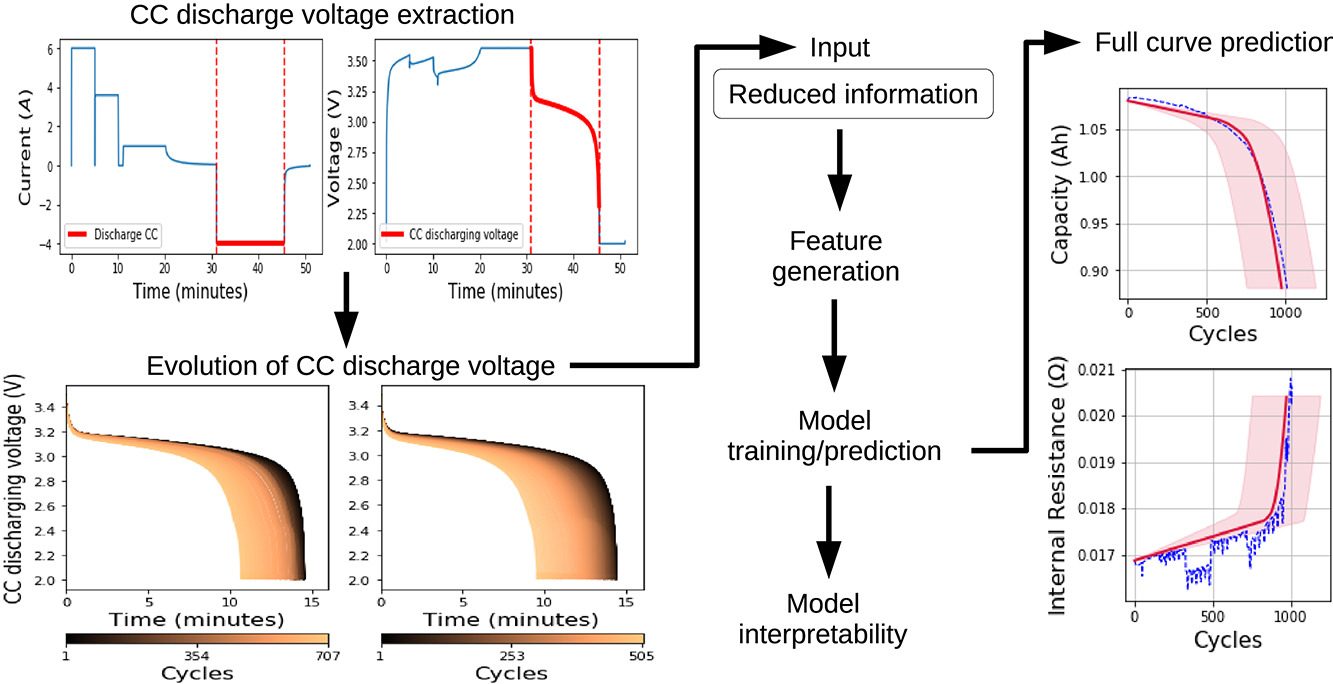This repository contains the codes for all the experiments performed in the research titled Capacity and Internal Resistance of lithium-ion batteries: Full degradation curve prediction from Voltage response at constant Current at discharge. The corresponding published paper can be downloaded free here.
The use of minimal information from battery cycling data for various battery life prognostics is in high demand with many current solutions requiring full in-cycle data recording across 50-100 cycles. In this research, we propose a data-driven, feature-based machine learning model that predicts the entire capacity fade and internal resistance curves using only the voltage response from constant current discharge (fully ignoring the charge phase) over the first 50 cycles of battery use data. This approach is applicable where the discharging component is controlled and consistent, but sufficiently general to be applicable to settings with controlled charging but noisy discharge as is the case of electric vehicles.
Below is the graphical abstract of the research paper:
- Clone the repository by running
git clone https://github.com/Rasheed19/cc-voltage-project.git - Navigate to the root folder, i.e.,
cc-voltage-projectand create a python virtual environment by runningpython -m venv .venv - Activate the virtual environment by running
source .venv/bin/activate - Prepare all modules and required directories by running the following:
make setup make create-required-dir - Run
run_download.pyto download the raw data used in this study. These are the data that correspond to- all the batches of data in this link https://data.matr.io/1/ which are the data for the papers Data driven prediciton of battery cycle life before capacity degradation by K.A. Severson, P.M. Attia, et al and Attia, P.M., Grover, A., Jin, N. et al. Closed-loop optimization of fast-charging protocols for batteries with machine learning. Nature 578, 397–402 (2020).
- the internal resistance data used to complement batch 8 downloaded from https://doi.org/10.7488/ds/2957 which is published in the paper Strange, C.; Li, S.; Gilchrist, R.; dos Reis, G. Elbows of Internal Resistance Rise Curves in Li-Ion Cells. Energies 2021, 14, 1206.
After setting up the project, you can then start running the provided entrypoints (run_train.py and run_experiment.py for the model training and various experiment pipelines respectively) with their respective arguments as CLI. For instance to train the proposed models, using the proposed train-test cell splits, including the feature importance and parity analysis, and given that the data has not been loaded, run:
python run_train.py --not-loaded --include-analysis
To run the experiment that focuses on the effect of voltage sub-sampling on model performance, say the model that predict cycles, run
python run_experiment.py --model-type cycle_at_model --experiment-type time-step-effect
To see all the available arguments or options to an entry point, e.g., for training pipeline entry point run:
python run_train.py --help
If you use this work in your project, please cite:
@article{IBRAHEEM2023232477,
title = {Capacity and Internal Resistance of lithium-ion batteries: Full degradation curve prediction from Voltage response at constant Current at discharge},
author = {Rasheed Ibraheem and Calum Strange and Gonçalo {dos Reis}},
journal = {Journal of Power Sources},
volume = {556},
pages = {232477},
year = {2023},
issn = {0378-7753},
doi = {https://doi.org/10.1016/j.jpowsour.2022.232477},
url = {https://www.sciencedirect.com/science/article/pii/S0378775322014549},
}
